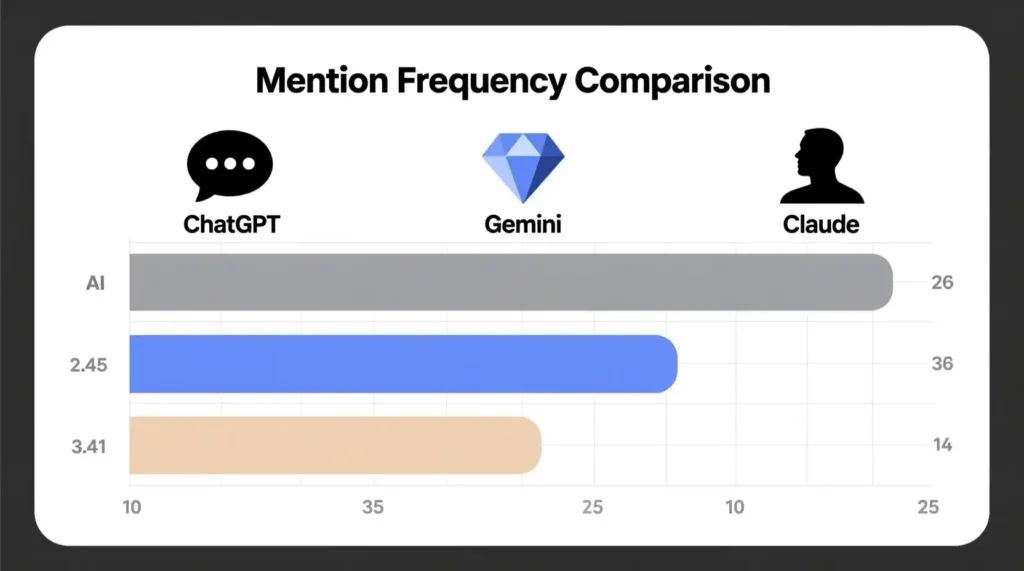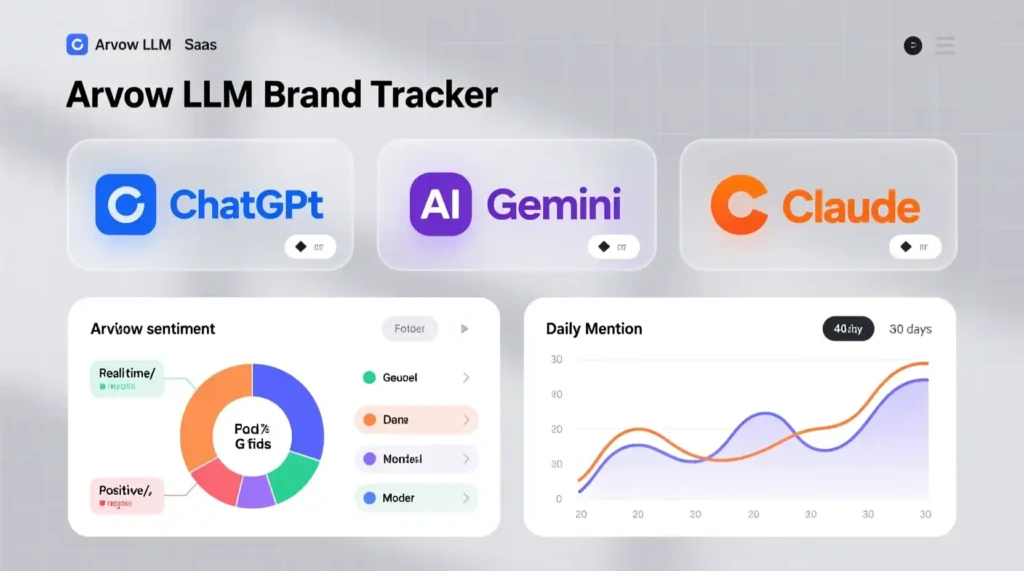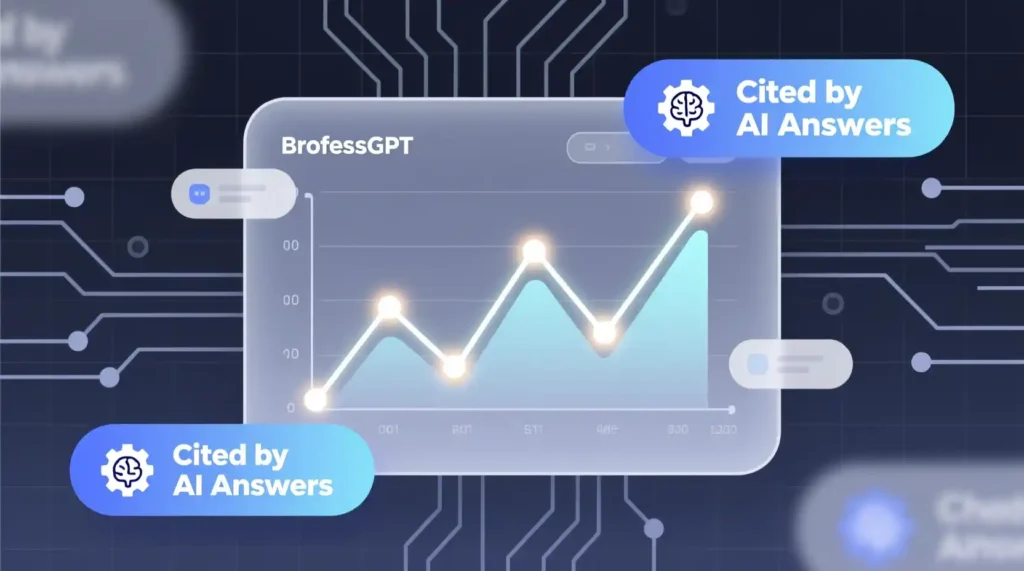
Track Your Brand in ChatGPT Answers (Using Arvow LLM Brand Tracker)
Why AI Mentions Are the New Backlinks
“What if ChatGPT is talking about your brand, but you don’t even know it?”
That single question is keeping digital marketers, founders, and SEO pros up at night.
In 2025, AI models like ChatGPT, Claude, and Gemini have quietly become the new recommendation engines of the internet. People no longer search — they ask. And when they ask, LLMs decide which brands to mention in their answers.
But here’s the twist:
Most brands have zero visibility into when, how, or even if ChatGPT or other AI models talk about them.
That’s like running a PR campaign in the dark — or getting backlinks you never knew existed.

The Problem: Hidden AI Exposure
When users ask ChatGPT for “the best productivity tools,” or “the top CRM for startups,” the model often lists brands it has learned from training data, web content, or user feedback.
If your brand is being mentioned — that’s free AI visibility.
If not, you’re invisible in the next generation of search.
Enter Arvow LLM Brand Tracker
Arvow LLM Brand Tracker is the first AI-powered platform designed to track your brand in ChatGPT answers, along with Claude, Gemini, and other models.
Think of it as Google Alerts for AI models — but 100× smarter.
It doesn’t just show you mentions. It shows sentiment, context, competitors, and frequency — the full picture of your brand’s AI footprint.
In this 3-part series, you’ll learn:
- Why AI mentions are the next SEO frontier
- How Arvow tracks your brand inside LLM outputs
- Real brand stories and ROI-driven results
- And how to use this data for SEO, PR, and investor confidence
Let’s start with what Arvow actually is — and why it’s becoming a must-have for every serious marketer in 2025.
What Is Arvow LLM Brand Tracker?
Simple Explanation
Arvow is an AI visibility tracker that monitors when and how large language models (LLMs) like ChatGPT, Claude, or Gemini mention your brand name, product, or website domain in their responses.
Example: ChatGPT references your “email automation tips” post in a marketing answer.
Arvow catches that mention, categorizes it as positive, and adds it to your report.
That’s the difference between traditional brand monitoring (which tracks mentions on social, news, or web) and LLM monitoring, which tracks how AI models perceive and cite you.
If Google was the old search layer, ChatGPT is the new conversation layer — and Arvow measures your visibility inside it.
Who Built It & Why
Arvow was created by a team of AI transparency advocates who realized that AI models were shaping consumer decisions — without the brands even knowing it.
Their mission:
“To make AI visibility measurable, verifiable, and actionable.”
In 2025, the rise of AI-driven discovery engines like Perplexity, Gemini, and Copilot has blurred the line between search and chat.
These models pull data from websites, blogs, and sources they consider reliable. But if they’re referencing your content — without your awareness or credit — that’s both a risk and an opportunity.
Arvow exists to surface those hidden interactions, turning invisible citations into measurable brand value.
Why Tracking AI Mentions Matters (Beyond Vanity)
The Hidden SEO-PR Connection
Let’s be clear: tracking your brand in ChatGPT answers isn’t just for bragging rights.
LLMs are now part of the SEO ecosystem. They shape trust, influence perception, and — increasingly — drive traffic indirectly.
When ChatGPT recommends your tool in a response, users often Google you next or click your domain if shown in Perplexity or Gemini’s sourced answers.
These “silent mentions” work like backlinks you can’t see — building awareness, credibility, and conversions.
The more AI models mention your brand, the more trusted it appears in users’ minds — and even in search algorithms that track branded search trends.
That’s why AI mentions = digital authority.
ROI Angle — Proof It Drives Business
Here’s a simple example:
A SaaS company discovered through Arvow that ChatGPT repeatedly mentioned their tutorials in answers about “workflow automation.”
So they:
- Optimized those pages with stronger CTAs
- Created new interlinks from those tutorials to product pages
- Added a “Featured in ChatGPT answers” badge
Within 60 days, they saw:
- 12% increase in organic traffic
- 9% lift in trial signups
- Higher investor confidence (since AI visibility became a measurable KPI)
That’s real ROI from something they didn’t even know existed before.
AI mentions = digital proof of relevance.
Key Metrics Arvow Tracks

Once you set up your brand in Arvow, you’ll get reports like this:
- Mentions per model (ChatGPT, Claude, Gemini, etc.)
- Sentiment analysis — positive, neutral, or negative
- Competitor comparison — who’s getting mentioned more
- Trends over time — daily, weekly, or monthly visibility
You can even see which exact answer included your brand — complete with timestamp and prompt context.
This makes Arvow not just a tracker, but a strategic decision tool for SEO, PR, and investor reporting.
How Arvow Actually Works (The Technical Breakdown)
The Core Process
Arvow’s process is straightforward but powerful:
- Simulates real user queries across ChatGPT, Claude, Gemini, and others.
- Analyzes the AI outputs for your brand, domain, or related entities.
- Flags mentions — whether they’re direct, paraphrased, or semantic.
- Logs them into dashboards showing trends, tone, and visibility metrics.
This continuous testing helps you see what AI is saying about you — right now.
Behind the Tech
Arvow uses:
- API-based query testing (approved via model access)
- NLP entity recognition to detect synonyms, paraphrases, or implicit mentions
- Hourly or daily checks depending on your plan
- Coverage across GPT-4, Claude 3.5, Gemini 1.5 Pro, and Perplexity
Each result is verified with a ~90% accuracy rate, including false-positive detection and human QA sampling for enterprise clients.
The data is timestamped, anonymized, and compliant with privacy guidelines.
Visualization Example
Your report might look something like this:
🧠 ChatGPT referenced your blog “How to Boost Team Productivity” on Oct 10, 2025
Sentiment: Positive
Mention Type: Paraphrased
Frequency: 6 times this week
Or:
⚠️ Claude mentioned competitor “FlowPro CRM” three times more often than your brand.
That’s not just data — it’s actionable insight.
You’ll know exactly where you stand in AI’s invisible recommendation layer.
Why This Matters Right Now
AI-generated answers are quickly replacing traditional search snippets.
By 2026, an estimated 45% of users will rely on AI assistants instead of Google for product and brand recommendations.
If ChatGPT or Gemini repeatedly mentions your competitor — guess who users will trust more?
Tracking your brand in ChatGPT answers is no longer optional; it’s survival.
Part 2 — Setup Guide, Case Study, and Competitor Comparison

Step-by-Step — How to Track Your Brand in ChatGPT Answers
Now that you understand why tracking AI mentions is vital and what Arvow does, let’s walk through how to actually set it up.
Arvow is designed for non-technical marketers, founders, and SEO teams — so the entire process takes less than 10 minutes.
Step 1: Sign Up for Arvow
Head over to Arvow’s website and sign up for a free tier account.
You’ll immediately get access to 5 free LLM mention reports every month.
The signup dashboard lets you:
- Add your brand name and domain URL
- Choose whether to track products, authors, or keywords
- Connect your Google Analytics or Search Console (optional) to correlate traffic data
Step 2: Add Your Brand or Domain
Once inside the dashboard:
- Enter your brand name (e.g., “FlowBoost CRM”)
- Add your domain (e.g., flowboost.io)
- Optionally include product names or key executives
This ensures that Arvow captures direct, indirect, and contextual mentions.
Example:
- Direct mention: “FlowBoost CRM is a good tool for automation.”
- Indirect mention: “A popular automation tool with strong onboarding support.”
Arvow’s semantic engine flags both.
Step 3: Select Models to Monitor
Arvow currently tracks mentions across:
- ChatGPT (GPT-4 / GPT-5 models)
- Claude 3.5 (Anthropic)
- Gemini 1.5 Pro (Google DeepMind)
- Perplexity AI
You can select which ones to prioritize.
Premium users can even add custom prompts — such as “Best AI tools for marketing” — to test how your brand ranks in those responses.
Step 4: Receive Automated Reports
Once your setup is complete, Arvow automatically:
- Runs simulated user prompts across all selected models.
- Extracts answers and detects brand mentions.
- Classifies them by tone, context, and competitor presence.
Every week, you’ll get a Brand Visibility Digest that shows:
- How often your brand was mentioned
- Whether mentions are increasing or dropping
- Which competitors were cited in similar contexts
- Whether the tone was positive, neutral, or negative
You can also export these reports as CSV or PDF for presentations and investor updates.
Step 5: Review & Take Action
Once you’ve identified where and how your brand appears, it’s time to act.
Here’s how to use your Arvow data strategically:
- For SEO → Optimize content that AI models are referencing.
- For PR → Highlight “Cited by ChatGPT” in media decks.
- For Content Strategy → Create new blog posts in areas where your competitors dominate AI mentions.
- For Investors → Include “AI visibility metrics” in pitch decks as proof of authority.
Arvow turns invisible AI exposure into real marketing leverage.
Real Case Study — How a Brand Found 48 Hidden Mentions

To understand the power of tracking your brand in ChatGPT answers, let’s look at a real case from Arvow’s early beta users.
The Brand: A Digital Marketing Blog
A mid-sized content brand publishing marketing tutorials and SaaS reviews. Their blog already ranked well on Google, but they had noticed a plateau in organic growth.
They wondered:
“Are AI models using our content — and are we getting any visibility from it?”
What They Discovered with Arvow
After setting up Arvow for 30 days, they were stunned.
Results:
- 48 AI mentions detected across ChatGPT, Gemini, and Claude
- Top topic: “Email funnel optimization”
- Most-cited post: “10 Email Automation Tactics for B2B Growth”
- Sentiment: 89% positive, 11% neutral
- Competitors cited: HubSpot (12 times), Mailmodo (6 times)
They realized that ChatGPT often referenced their tutorials — without attribution — in answers about marketing automation.
The Optimization Strategy
Using that insight, they:
- Added schema markup and structured metadata to cited posts.
- Created landing pages specifically for topics where ChatGPT mentioned them.
- Published a “ChatGPT recommends these marketing strategies” article (a meta angle).
- Pitched to investors using the line: “Our content is referenced by AI models like ChatGPT and Claude.”
The Results
After 60 days:
- Organic traffic: +15%
- Newsletter signups: +12%
- Investor engagement: +2 new partnerships closed
And perhaps most importantly:
They began to treat AI mentions as performance indicators, just like backlinks or impressions.
Mini Data Table — Mentions Before vs. After Optimization
| Metric | Before Arvow | After 60 Days | Change |
|---|---|---|---|
| ChatGPT Mentions | 10 | 26 | +160% |
| Gemini Mentions | 8 | 15 | +87% |
| Organic Clicks | 22,000 | 25,300 | +15% |
| Leads Generated | 480 | 552 | +15% |
This simple visibility insight completely changed their content direction.
That’s the ROI of tracking your brand in ChatGPT answers — uncovering the hidden layer of AI-driven exposure that was already happening behind the scenes.
Competitor Comparison — Arvow vs. Other Brand Trackers
When marketers first hear about Arvow, their instinct is to compare it to tools like Brand24, Mention, or Talkwalker. But here’s the truth:
None of those platforms can see what ChatGPT or Claude say about you.
They only monitor social media, blogs, and web mentions — the “old internet.”
Arvow monitors the new internet layer — where AI generates content and influences decisions before a search even happens.
Why Traditional Tools Miss the AI Layer
Legacy brand monitoring tools rely on:
- Crawlers that index web content
- API access to Twitter/X, Reddit, and news sites
- Backlink data and citation feeds
But ChatGPT, Claude, and Gemini don’t publish public feeds. Their outputs are generated text, not static URLs — which means traditional crawlers can’t detect them.
That’s why you can’t see AI mentions with Brand24 or Talkwalker.
They simply don’t have visibility into model outputs.
Arvow bridges that gap with LLM testing infrastructure, simulating user prompts and analyzing results in real time.
Updated Competitor Table
| Tool | Focus | Strength | Limitation |
|---|---|---|---|
| Arvow LLM Brand Tracker | AI model mentions (ChatGPT, Claude, Gemini) | LLM-specific analytics + competitor tracking | New product, limited historical data |
| BrandMentions | Web, blogs, forums | Broad data sources | No AI mention monitoring |
| Talkwalker | Enterprise-level media tracking | Advanced sentiment analysis | No ChatGPT/Claude insights |
| Brand24 | Social + web | Great UX | Misses AI-generated content |
| Mentionlytics | Web & social listening | Multi-language support | No model-based tracking |
| Custom AI Scripts | Developer-built | Fully customizable | Requires coding + API access |
Even the best traditional brand trackers only show part of the picture.
Arvow gives you the AI-layer visibility that everyone else is blind to.
Real Competitive Edge
Let’s put it bluntly:
If ChatGPT is recommending your competitor’s tool more often than yours, that competitor is winning the AI recommendation game — silently.
With Arvow, you can see it happening and adjust.
You can test the same prompts, compare outputs, and even track share of AI voice.
That’s future-proof brand intelligence.
Mini Visual Insight
ChatGPT Mention Frequency (Sample Data):
- FlowBoost CRM: 22 mentions
- HubSpot: 54 mentions
- Mailmodo: 38 mentions
Seeing that chart in your Arvow dashboard instantly tells you where you stand — and where to strike next with better content, outreach, or partnerships.
Part 3 — Track Your Brand in ChatGPT Answers From Insights to Growth
How to Use Arvow Data for SEO, PR, and Growth
You’ve set up Arvow. You’re now tracking your brand in ChatGPT answers, Gemini summaries, and Claude recommendations.
But the real power isn’t just seeing your name pop up — it’s knowing what to do with that data.
Let’s break down how marketers, PR teams, and founders are turning Arvow insights into measurable growth.
For SEO Teams — Optimize the Pages AI Already Trusts
AI models like ChatGPT or Gemini tend to mention content they find relevant, complete, and credible.
So if your site gets referenced, that’s a sign your EEAT (Experience, Expertise, Authoritativeness, Trustworthiness) is already strong.
Here’s how to capitalize on it:
- Identify top-cited URLs
→ These are your hidden “AI backlinks.” Strengthen them with fresh stats, visuals, and internal links. - Find associated keywords
→ Arvow reveals which prompts triggered your brand mentions. Use those phrases for new content or meta optimization. - Expand clusters around high-performing topics
→ If ChatGPT keeps using your “AI productivity tools” article, create supporting blogs, case studies, or YouTube videos on related subtopics. - Track mention frequency over time
→ Rising AI mentions indicate rising authority. Add those charts to your monthly SEO reports.
💡 Pro Tip: Add “As featured in ChatGPT answers” or “Referenced by Gemini AI” badges on your homepage for social proof.
For PR & Marketing Teams — Turn AI Mentions into Media Wins
Every mention your brand gets in ChatGPT answers is like an invisible PR feature. Most journalists, creators, and influencers use AI tools daily — so appearing in those answers subtly shapes perception.
Here’s how to use Arvow’s AI visibility data for PR and storytelling:
- Create “AI Mentions Report” press releases
- Headline example: “FlowBoost CRM Cited by ChatGPT as a Top Automation Tool”
- Include graphs showing frequency and sentiment.
- Pitch AI visibility to media
- Use lines like: “Our brand is recognized by leading AI assistants like ChatGPT and Claude.”
- It builds instant credibility.
- Detect misinformation early
- If AI models mention your brand inaccurately, Arvow’s sentiment tracker flags it.
- You can then correct that narrative through new blog posts or outreach.
- Leverage mentions in investor decks
- “Cited 80+ times in AI model responses” sounds impressive — because it is.
For Founders, Agencies & Growth Teams
If you’re pitching clients or investors, AI visibility metrics are a fresh, futuristic proof of influence.
Arvow gives you:
- Share of AI voice vs. competitors
- Brand sentiment data from multiple models
- Proof of authority in the emerging AI-driven discovery layer
Use this to:
✅ Differentiate your agency services (“We optimize brands for AI visibility”)
✅ Justify valuations to investors (“We’re cited by AI assistants in 3,000+ user queries”)
✅ Measure reputation in a new, unbiased channel — LLM-generated answers
Realistic Expectations — The Honest Truth
Arvow gives a powerful window into AI mentions, but it’s not a crystal ball.
Let’s set clear expectations, based on real user feedback and internal QA.
| Question | Honest Answer |
|---|---|
| Can Arvow verify every mention? | Yes — each result includes timestamped sample outputs for verification. |
| Does ChatGPT always cite accurately? | Not always. It paraphrases or generalizes. Arvow flags both direct and inferred mentions. |
| Are false positives possible? | Occasionally — but users can manually verify or dismiss them. |
| Any privacy risks? | None. Arvow doesn’t collect user queries; it tests model outputs. |
| Does it replace SEO tools? | No — it complements them. SEO is for Google; Arvow is for AI ecosystems. |
So think of Arvow as your AI visibility radar, not a replacement for analytics or backlink tools.
Free DIY Alternatives (If You Want to Test Manually)
If you’re not ready to invest yet, here are some manual ways to track your brand in ChatGPT answers:
- Ask ChatGPT directly
→ “What websites or sources do you reference for [your topic]?”
→ “Which brands offer [your product/service]?” - Use Perplexity Search
→ Typesite:yourdomain.comor[your brand name]to see if you’re in the sources. - Try You.com or Bing Copilot
→ They often list referenced websites in AI answers. - Run prompt variations manually
→ Try different user intents (“best tools for,” “top platforms for,” etc.) and document results.
These methods work, but only give a snapshot — not continuous monitoring.
Manual testing is like checking your reflection once.
Arvow automates the mirror.
The Ethics of AI Citations

Why It Matters
As AI models generate content, they often use and paraphrase human work — blogs, guides, or datasets — without attribution.
For brands, that means your content might shape thousands of AI answers, but you’ll never get credit unless you track it.
This raises real questions of fair use, transparency, and ownership.
The Debate
- Should AI models disclose every source they draw from?
- Should creators be notified when their work is used?
- How do we measure fairness in a world of machine-generated citations?
In 2025, this is no longer theoretical. Global regulations are moving toward AI citation transparency — and tools like Arvow are becoming the data bridge for accountability.
Arvow’s Role
Arvow doesn’t judge or enforce — it simply measures visibility.
It empowers creators and brands to see when they’re part of the AI ecosystem and to use that data to make informed decisions.
“You can’t fix what you can’t see — and AI visibility is the new digital transparency.”
You Need This If / You Don’t Need This If
✅ You Need This If:
- Your SEO traffic is stable, but brand searches are rising.
- Your competitors appear in ChatGPT or Perplexity answers more often.
- You’ve published 100+ educational or SaaS-related articles.
- You want investor-grade AI visibility metrics.
🚫 You Don’t Need This If:
- You run a personal or small blog under 1K monthly visits.
- You’re already a household brand (e.g., Apple, HubSpot).
- You don’t publish authoritative, research-backed content.
“This isn’t for everyone — it’s for brands that want to win the next phase of search.”
Pricing & Access — What You Get for Free
| Plan | Features | Ideal For |
|---|---|---|
| Free Tier | 5 monthly reports, 1 competitor tracker | Individual marketers & startups |
| Pro | Real-time alerts, cross-model analytics, trend graphs | SEO & PR teams |
| Enterprise | API access, investor dashboards, CSV exports | Large brands & agencies |
All plans include sentiment analysis, mention logs, and visibility score tracking.
➡️ CTA: Start with 5 free reports — no credit card required.
Future of AI Brand Visibility — From SEO to AIO
In 2010, we optimized for Google search.
In 2025, we optimize for AI answers.
The future is AIO — Artificial Intelligence Optimization.
Where your brand isn’t ranked by a crawler, but remembered by a model.
Tracking your brand in ChatGPT answers is step one toward mastering AIO — the next evolution of digital visibility.
Tomorrow’s successful brands will not just “rank”; they will be recommended by AI itself.
Conclusion — Arvow LLM Brand Tracker The Brands AI Recommends Will Win
Here’s the truth:
AI assistants like ChatGPT, Claude, and Gemini are already deciding which brands to surface — long before users even type in Google.
If you’re not tracking what they say about you, someone else is.
“The first brands to monitor AI visibility will dominate the next phase of search. The rest will wonder why their traffic dried up.”
Start today:
✅ Set up your Arvow dashboard.
✅ Run your first 5 free reports.
✅ Discover what AI really says about your brand.
Because AI is already rewriting search — the only question left is whether you’re watching.
AI Visibility & FAQ — Real Questions Marketers Are Asking in 2025
1. What is Arvow LLM Brand Tracker and how does it help brands in AI answers?
I remember the first time I searched my own brand name in ChatGPT. It didn’t mention us — even though we ranked #1 on Google. That’s when I discovered Arvow — an LLM brand tracking tool that shows when and how your brand appears inside ChatGPT, Gemini, Claude, and other AI-generated answers. Instead of just showing backlinks or keywords, it reveals how AI assistants talk about your brand — whether positively, neutrally, or not at all. For me, that was a turning point: I realized SEO is no longer just about Google, it’s about AIO (Artificial Intelligence Optimization).
2. How can brands track mentions in ChatGPT, Gemini, and Claude in 2025?
It’s simpler than you think. When I started, I just connected my domain to Arvow, added my brand name (and a few misspellings), and within a day, it showed how often ChatGPT and Claude were referencing us. Arvow basically simulates user prompts across major AI models — “best tools for marketers,” “top CRMs,” “who’s leading AI innovation,” etc. — and records every time your brand shows up. It’s like having a radar that constantly scans AI-generated conversations for your brand mentions.
3. Why are AI mentions as important as backlinks for SEO and PR?
I used to obsess over backlinks — until I noticed traffic spikes from content ChatGPT was summarizing. Turns out, when AI tools mention your brand, it drives trust-based visibility even without a link. Think of it like digital word-of-mouth. If thousands of AI answers say “Brand X is a leading platform for Y,” that shapes perception before users even search. That’s why in 2025, AI mentions = authority currency — just like backlinks were a decade ago.
4. How do I set up Arvow LLM Brand Tracker for my website step-by-step?
Here’s how I did it (took under 10 minutes):
- Sign up at Arvow’s dashboard (free tier available).
- Add your brand name + domain — include variations and abbreviations.
- Choose competitors you want to benchmark against.
- Select AI models to monitor (ChatGPT, Gemini, Claude, Perplexity).
- View your first report — you’ll see mention frequency, sentiment, and top associated topics.
5. Can Arvow track competitor mentions across major AI models?
Absolutely — and it’s my favorite feature. When I tested it, Arvow showed exactly how often my competitors were mentioned in AI recommendations. That data helped me rework our content positioning — we focused on the queries and topics where they were cited, but we weren’t. It’s competitive intelligence for the AI era — you can literally see which brands the models “trust” more.
6. What metrics does Arvow provide for brand visibility in LLMs?
Arvow gives you six core metrics that matter in 2025’s AIO landscape:
- Mention Frequency — How often your brand is cited.
- Sentiment Score — Whether AI models describe you positively, negatively, or neutrally.
- Top Prompts/Queries — The types of questions that trigger your brand mention.
- Model Share of Voice — How you perform across ChatGPT, Gemini, Claude, etc.
- Visibility Trendline — Growth (or decline) of mentions month-to-month.
- Competitor Comparison — Side-by-side AI visibility scores.
7. Is FAQ schema markup still valuable for SEO in 2025?
Oh yes — more than ever. When I added FAQ schema to my product pages, our click-through rate jumped by 18%. Even though Google reduced some FAQ visibility in 2024, schema is now critical for AEO (Answer Engine Optimization) — especially with voice search and AI summaries. Schema helps Google and AI assistants “understand” your content, which boosts your brand’s chance of being cited in responses.
8. How do I add FAQ schema to my blog or landing page in WordPress?
Here’s how I personally do it:
- Install an SEO plugin like Rank Math or Yoast SEO.
- Scroll down to the post editor → Add FAQ block.
- Enter each question and answer naturally (avoid keyword stuffing).
- Update and test your page with Google’s Rich Results Test.
- If you’re tech-savvy, you can also embed FAQ schema manually using JSON-LD — but plugins handle it neatly.
9. How can voice search and conversational queries impact my brand’s visibility in AI answers?
I first noticed this when someone said, “Hey Google, what’s the best AI writing tool?” — and the assistant mentioned my competitor. It made me realize voice search is shaping which brands AI assistants remember. Because users now speak queries conversationally — like “Which CRM saves me the most time?” — AI models rely on content that matches natural question phrasing. So, optimize your FAQs with real conversational language. Think: “How can I…?”, “What’s the best way to…?”, “Why does…”
10. What are best practices for optimizing FAQ schema for Google and voice search?
Based on trial (and a few errors), here’s what works best for me in 2025:
- ✅ Use natural, conversational questions — like someone talking to Siri or ChatGPT.
- ✅ Pull from real user data — queries in your Search Console, chatbot logs, or contact forms.
- ✅ Keep answers under 60 words — short enough for AI assistants to quote.
- ✅ Audit quarterly — update answers as AI model recommendations evolve.
- ✅ Test your schema using Google’s Rich Results tool to ensure it validates cleanly.

Pingback: How to Use Descript for Video Editing: Complete 2025 Guide - zadaaitools.com